VVAM Airborne Magazine vol.3 nr.8 2016
INHOUDSOPGAVE
3.-5.Additional Annual General Members Meeting of the Society of Friends of the Airborne Museum, which took place on 19 November 2016
5. -6.Hotel Dreyeroord: the current state of affairs – Robert Voskuil
6. -7.Booklet about Air Support teams – Wybo Boersma
7.Exhibition: “EGO. Do not forget me” – Robert Voskuil
8.Reburial of two soldiers at the Airborne Cemetery
9.Six unknown soldiers identified after 72 years
9.-10.Book reviews by Wybo Boersma
11.A “Regimental Aid Post” in the Concertzaal – Robert Voskuil
12.Royal decoration
12. -13.A very special emblem from the Airborne Museum collection – Wybo Boersma
13.“B Company Arrived, The Men”
13-14.Ministory 124, Hotel Dreyeroord, September 1944 – Niall Cherry
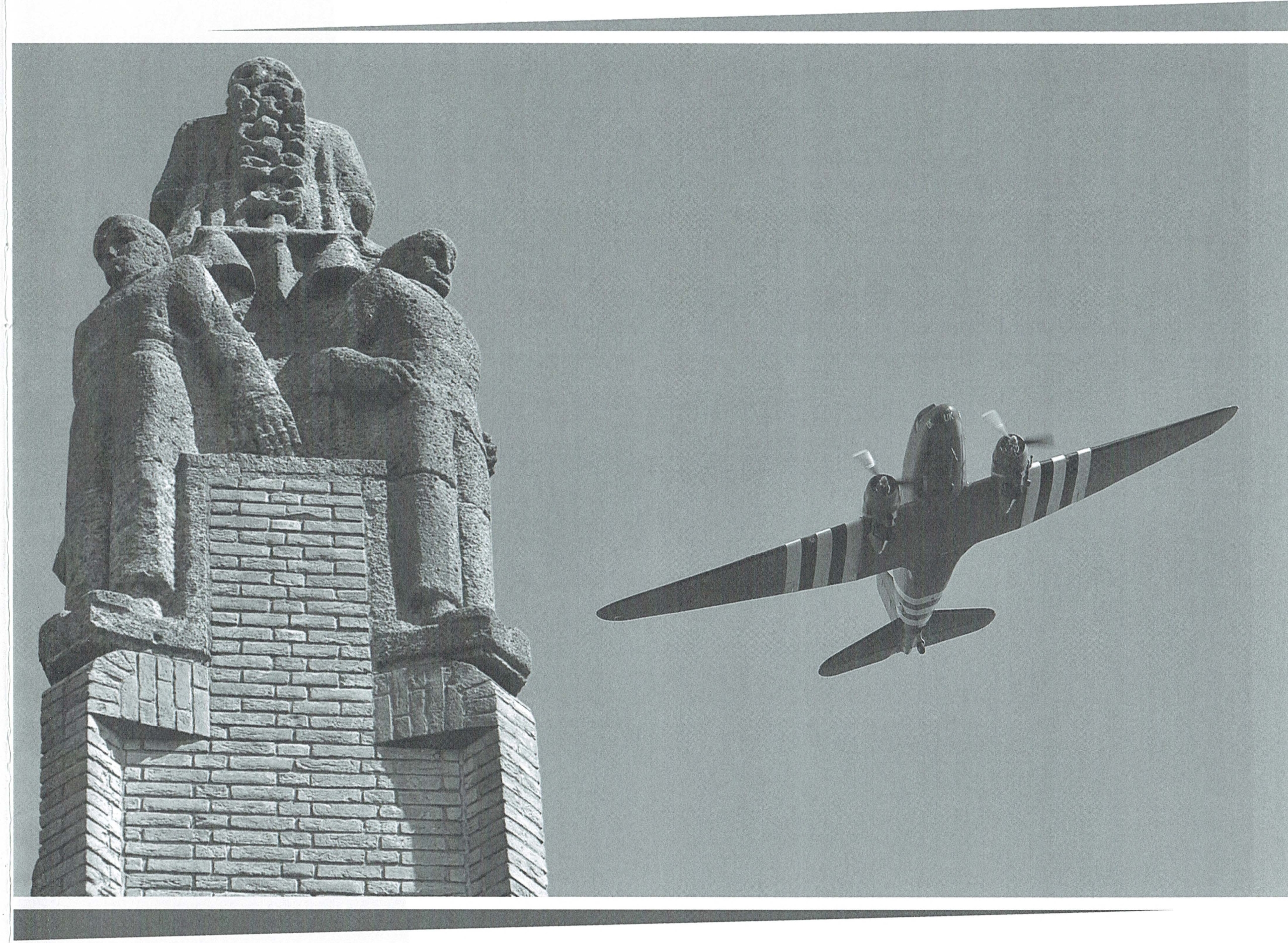
On Liberation Day (5th May 2016] a British Dakota flew over Hartenstein and the Airborne Monument in Oosterbeek. (photo: berrydereusfotografie.nl)
ADDITIONAL ANNUAL GENERAL MEMBERS MEETING OF THE SOCIETY OF FRIENDS OF THE AIRBORNE MUSEUM, WHICH TOOK PLACE ON 19 NOVEMBER 2016-10-22
On Saturday 19 November 2016, an additional Annual General Members Meeting of the SFAM took place. This had become necessary in that, during the past year, a situation has developed, from which, during the AGM on Saturday 19 March, a comprehensive exchange of thoughts and ideas took place. Those members then present, gave the Management instructions that they should take steps to construct and implement a renewed relationship with the Airborne Museum. To activate this plan, on 10 July 2016, the Society Management sent a letter to the management of the Airborne Museum Foundation. A copy of this letter is available on request.
In the run-up to the meeting on 19 March 2016, two members of the Management team announced their intention to resign from the team and eventually one candidate member was selected to join, without the usual election. The various reactions from members during and after the AGM, gave the Management the feeling that they should all resign with effect from the AGM on 19 November 2016.
In the following period, Mr Alex Koning announced his willingness to stand as a new member of the Board and in the coming months, with support from a committee of well qualified people, to form a new Management team. Therefore during the AGM on 19 November, Mr Koning was nominated as the sole Management team member. Also, you will be advised that, in the period from the Extra AGM on 19 November to the AGM in March 2017, the then resigned Management team members, Ben Koster, Wybo Boersma, Gerard Gijbertsen, Frits Miedema and Eric Paap, will arrange the transfer of their duties to the new Management team members, to be elected on March 2017.
Alex Koning lives in Rozendaal, is married and has two sons. He is a lawyer and has also worked as Manager and Director in the Netherlands Water industry. He is also, amongst others, a former Director of the Netherlands Water Museum in Arnhem. During his whole life, he has been active as a director of Foundations and Corporations, as well as societies of friends. He has a wide network in administration. His connection with the Battle of Arnhem originates from the fact that his Grandfather was the farmer of the Johannahoeve farm, North of Oosterbeek. His whole family had moved into the Johannahoeve and in September 19-44 they lived there through the Battle of Arnhem.
Alex has been a member of the SFAM for very many years. Every year, in September, he drives with enormous pleasure in his Willy’s Jeep from 1942.

Mr Alex Koning, who announced his willingness to stand as a new member of the Board.
‘ We will hopefully achieve a mutually and equal reciprocal and rewarding relationship, through which both parties can achieve their share of the future achievements, each from their own objectives.”
During the AGM, the new proposed Society Policy Plan was discussed. The Society will, under direction of a new Management team strengthen itself and look to the future. For this purpose, new concrete firm targets, plans and measures will be laid out, one and another to be explained in the policy plan. The existing statutes have more than enough room to allow changes. As a result, we hope, from a new and totally clear position, to clarify and make firm the future relationship with the Airborne Museum. With much pleasure and reward, we will support a maximum relationship. We will hopefully achieve a mutually and equal reciprocal and rewarding relationship, through which both parties can achieve their share of the future achievements, each from their own objectives.
The Society members are all ambassadors for the modern Airborne Museum. A museum that we support financially in their present format and where we, as Friends, have a special position. An abbreviated version of the policy plan has meanwhile been placed on the SFAM (WAM) website.
On the basis of the above details, the agenda for the AGM was as follows:
Agenda
Extra Annual General Meeting of the Society of Friends of the Airborne Museum.
Date: 19 November 2016 Commencing: 14.OOhr (hall opens 13,30) Location: Concert Hall, Rozensteeg 3., Oosterbeek
1. Opening
2. Announcements and notices of absences
3. Report AGM 19 March 2016
4. Resignation of current management members and election of Mr Koning as management member
5. Policy plans 2016-2021
6. Developments in the relationship between SFAM and the Airborne Museum
7. Initiatives and programme for 2017
8. Any other business
9. Closure
INTERVAL
The planned lecture by Martin Peters about the book “Desert Rise-Arnhem Descent” which appeared last April that he, together with Niall Cherry, John Howes and Graham Francis, wrote about the 10th Parachute Battalion during the WW2, was postponed to the next meeting of the SFAM
More details on the developments within the SFAM will be published in the first issue of the Airborne Magazine of 2017.
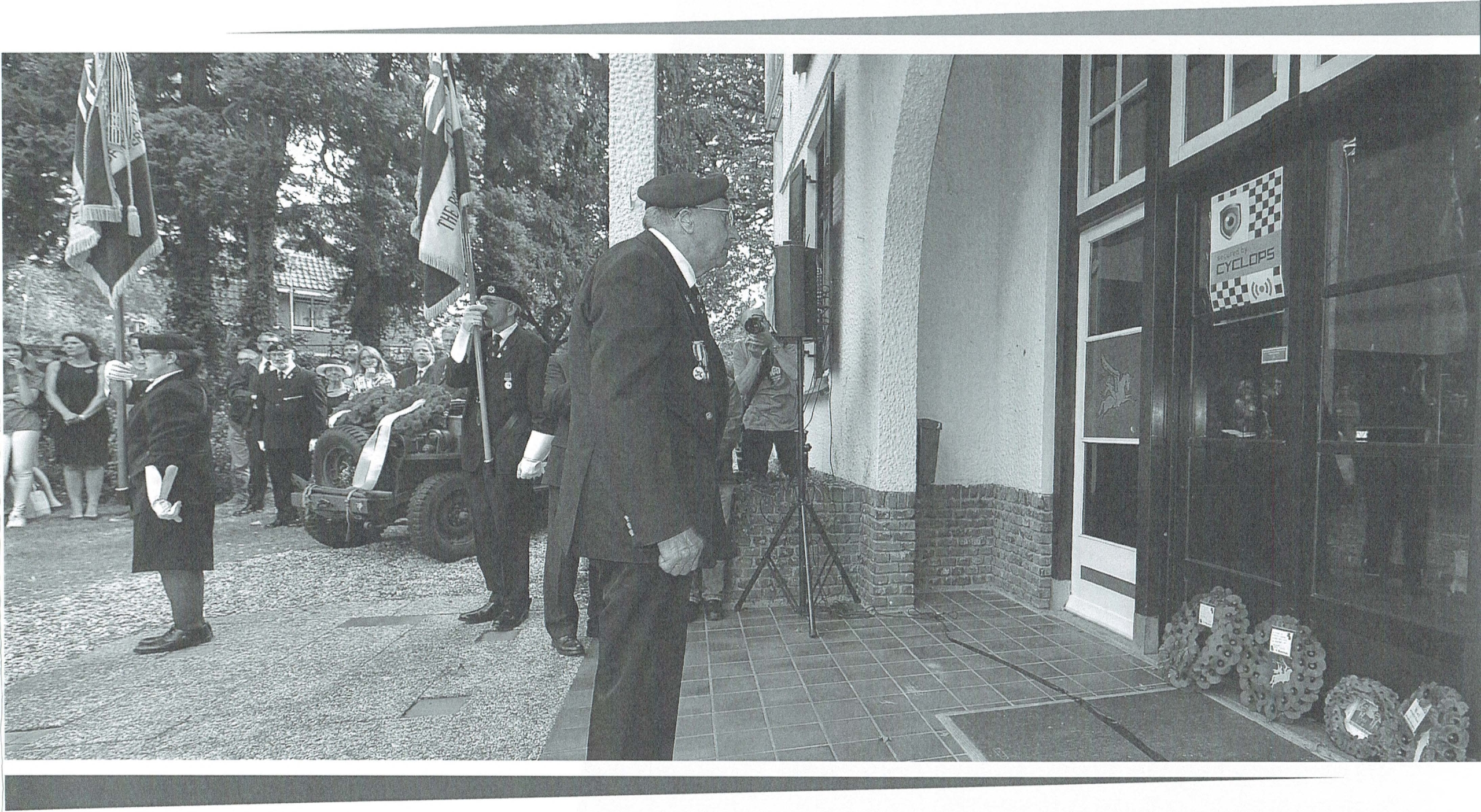
During the ceremony on Sunday 18 September 2016, veteran Geoff Roberts stood deeply in thoughts at the entrance to Hotel Dreyeroord where shortly before, he had laid a wreath. Geoff Roberts had fought at Dreyeroord in September 1944. (photo: berrydereusfotografie.nl)
HOTEL DREYEROORD: THE CURRENT STATE OF AFFAIRS
In the last edition of the Airborne Magazine, we mentioned the plans to demolish the Hotel Dreyeroord, that, between 19 and 21 September 1944, served as the HQ building for 7 KOSB. In the interim, the possible demolition of this historic building, has triggered a storm of protest. The Foundation “Behoud Dreyeroord Oosterbeek” (“Preserve Dreyeroord Oosterbeek”) was delighted with the overwhelming interest shown by many “supporters”. More than 15,000 signatures, opposing the demolition have recently been delivered to the Municipality of Renkum. Responses came in from 40 different countries. Also the home and foreign press have devoted frequent time and energy to the Hotel Dreyeroord issue. In the Netherlands, the subject even managed to appear in the national TV News programme. Very supportive was the letter from the UK Ambassador in the Netherlands, Sir Geoffrey Adams, which was sent to the acting Renkum Mayor, Mr Hein Bloemen. Sir Geoffrey wrote that it would be an enormous tragedy if Hotel Dreyeroord were demolished.
The “Preserve Dreyeroord Oosterbeek” Foundation has meanwhile engaged an Architect to undertake an investigation into whether it would be possible to make making a number of architectural changes to the existing building, to enable it to meet the planned future use as accommodation for pensioners with dementia, instead of its total demolition. The first proposal under this scheme has meanwhile been submitted and looks very promising. But that sadly does not yet mean that the fight against the demolition has been won!
On Sunday afternoon 19 September 2016, a short ceremony took place at Dreyeroord, at which Dutch and British people demonstrated their support towards the retention of the building with the placing of wreaths and flowers at the entrance. One of the speakers on this occasion was Niall Cherry. His presentation made a great impression on those present and therefore, the editors decided to publish his speech as a Ministory in this Airborne Magazine (see later in this issue).
/Robert Voskuil)
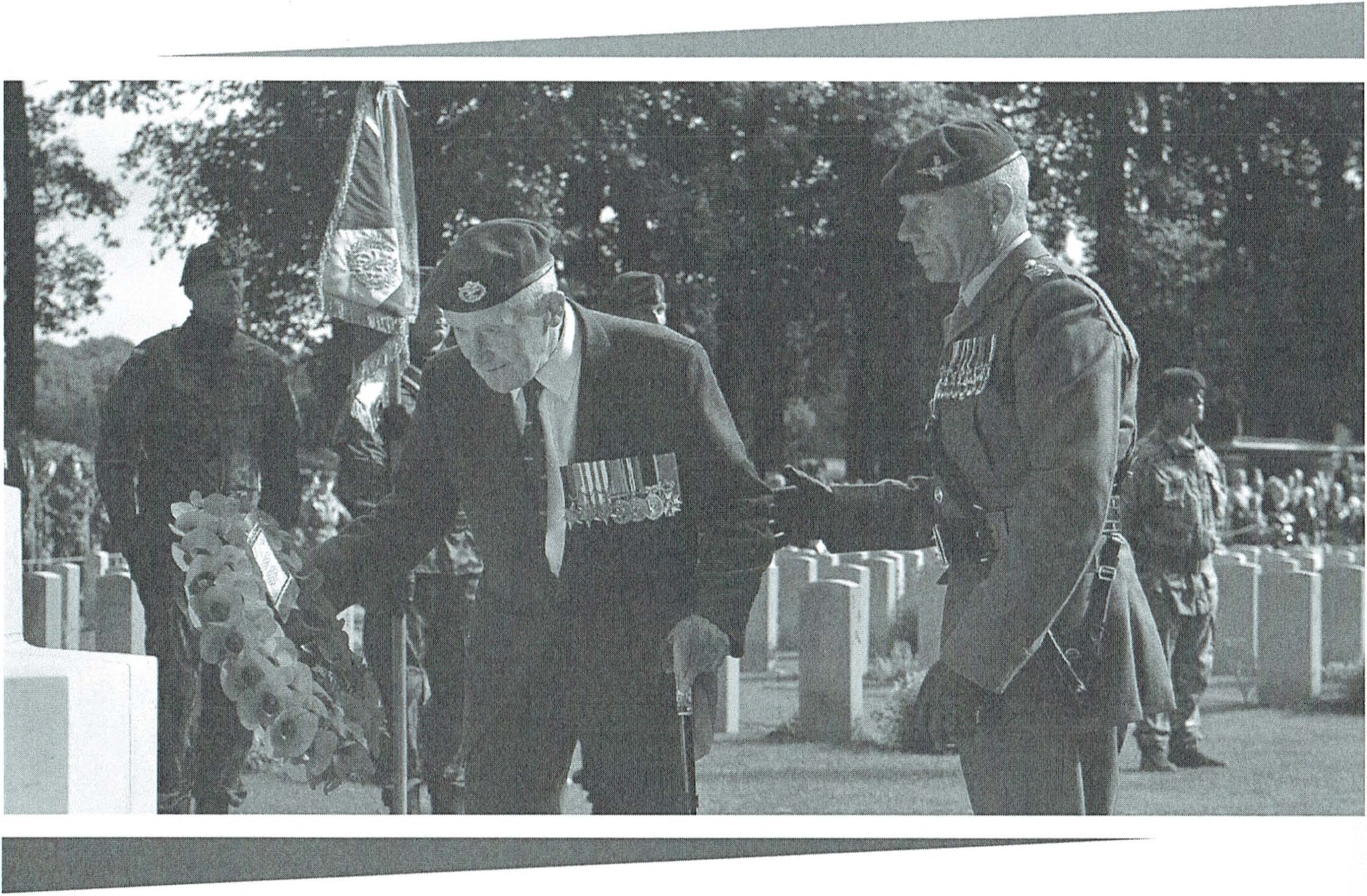
During the Memorial service at the Airborne Cemetery, the “leader of the Pilgrimage”, Laurie Weeden, who, in September 1944 served as a Staff Sergeant in the Glider Pilot Regiment, lays a wreath at the Cross of Sacrifice (photo: berrydereusfotografie.nl)
BOOKLET ABOUT AIR SUPPORT TEAMS
“US Air Support Signals Teams, Arnhem-Oosterbeek September 1944” by Wybo Boersma and Philip Rein-ders – Private publication 2016, 38 pages, illustrated, colour, English language, price €7,50.
As well as British, Polish and Dutch military personnel 14 American military personnel took part in the Battle of Arnhem. Ten of them formed two US Support Signals Teams, who were responsible for the groundair connections. Already in the After Action Report, published in 1945, we can read that this ground/air connection at Arnhem did not succeed. The most likely reasons for this, mentioned in this report, were that the American personnel were not fully trained, did not know fully their equipment and that they had taken the wrong crystals. From then until today this story has been used by almost all subsequent authors who have tried to dig deeper into the issues of the communications and air support. Just as much as the Dutch Commandos, the US Air Support Signal Teams were viewed with suspicion by the 1st British Airborne Division.
In the past, several people have done research into the matter. They traced a couple of the soldiers from the Signals Team. Their testimony, supported by documents and small parts from recent publications, have finally resulted in as complete as possible, a history of these hitherto partly unknown American signals teams. The inability to bring the ground/air connections into action, appears to be more due to a poor preparation by the British and the changed military situation, than to the presumed shortfall in training. Quite rightly, the new book “US Air Support Signal Teams” is a tribute to the small group of Americans who very rarely are mentioned in the existing literature. Their involvement was “rewarded” with seven months of imprisonment in Germany (POW), after which, finally, via Russia, they managed to return to America.
As well as to the 1st British Airborne Division, similar communications units were attached to both American Airborne Divisions. These probably suffered the same difficulties, but, to date, we have found no information about their history. Or possibly due to the widely spread deployment of the other American divisions, they were never actually posted to such a role, and their duties might have been taken over by the 30th British Corps. This could be the subject of a future research project.
The book can be ordered from the Vereniging Vrienden van het Airborne Museum website: www.vriendenairbornemuseum.nl or from w.boersmaldwxs.nl. The price of the book is € 7,50.
Postage and packing in Holland €2,50, overseas €7,50.
Also it is possible to purchase a copy during meetings and battlefield tours organised by the SFAM.
[Wybo Boersmal)
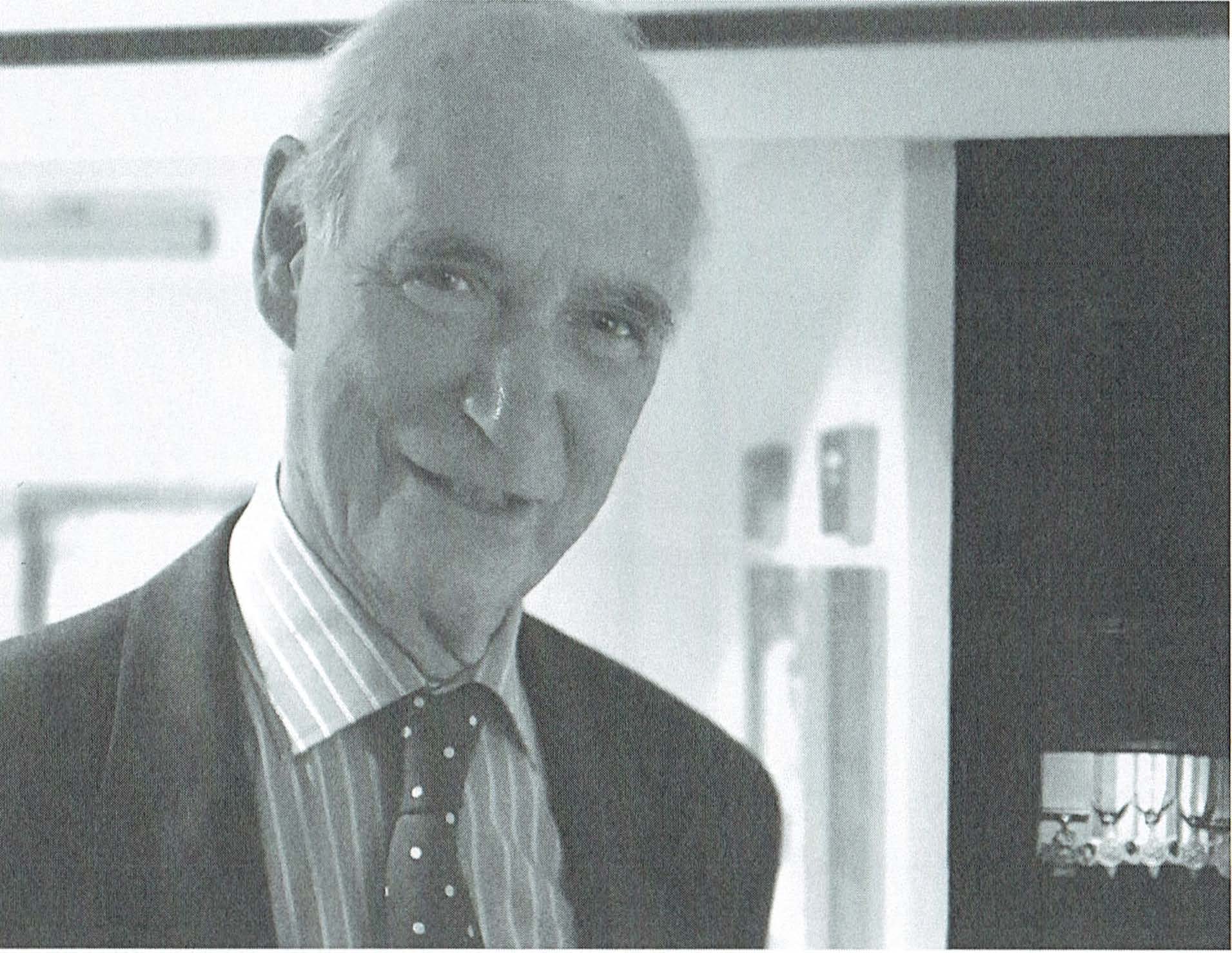
John Graybum, son of Lt John Jack” Graybum, who was killed at the Rhine Bridge in Arnhem on 20 September 7244, stands in the exhibition EGO in the Airborne Museum, with his father’s medal set in the background. The medal on the farthest leftside of the set, is the Victoria Cross. (photo: berrydereusfotografie.nl)
On 1st September 2016, Mr Pieter van Vollenhoven opened the new exhibition “EGO. Do not forget me”.
In this display, centrally appear the experiences of 68 people (EGO = ‘me’]. Based on the personal stories of British, Polish and German soldiers, and Dutch civilians, the Battle of Arnhem, but also the approach to the Battle and the aftermath, are shown in pictures in a penetrating fashion. Alongside stories and photos, a number of special objects are exhibited, that all have a close association with those people whose stories are told.
The most important item, is the original Victoria Cross, that was awarded posthumously to the British Lieutenant John “Jack” Hollington Grayburn, who died aged 26 years, at the Rhine Bridge in Arnhem.
Grayburn was in command of 2nd Platoon, A Company,
2nd Parachute Battalion. This Battalion was under the command of Colonel John Frost. Grayburn was the only soldier at the bridge, who was awarded the Victoria Cross. The full report of his actions during the Battle of Arnhem, appeared in the Supplement of the London Gazette of 23 January 1945. The last section of this “citation” read: “From the evening of September 17th until the night of September 20th 1944, a period of over three days, Lieutenant Grayburn led his men with supreme gallantry and determination. Although in pain and weakened by his wounds, short of food and without sleep, his courage never flagged. There is no doubt that, had it not been for this officer’s inspiring leadership and personal bravery, the Arnhem Bridge could never have been held for this time”.
His son John has worked on the exhibition and he attended the opening ceremony.
[Robert Voskuil)
REBURIAL OF TWO SOLDIERS AT THE AIRBORNE CEMETERY
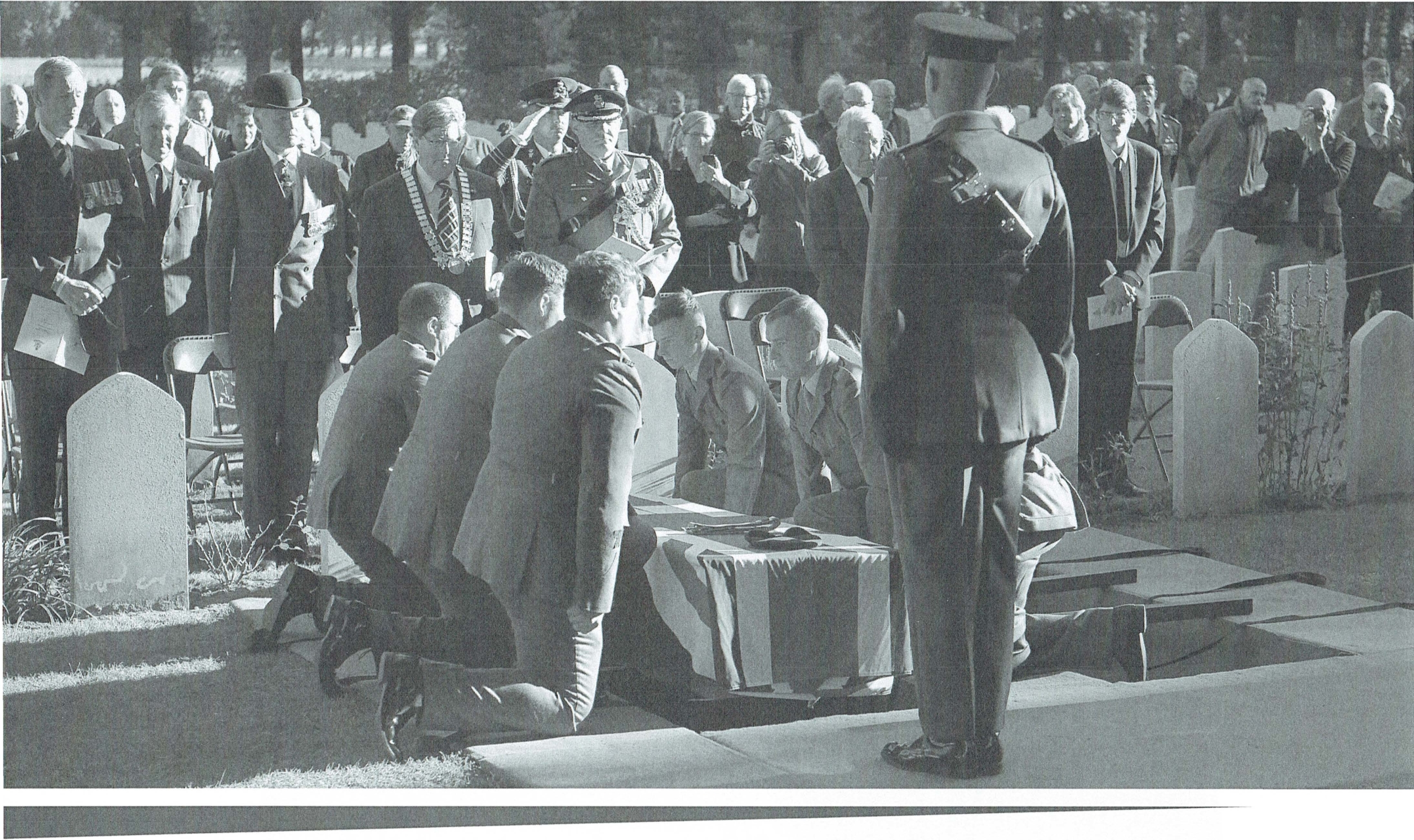
On 5th October 2016, Corporal Donald S. Noble and Private Harold J.
Lewis were reburied at tbe Airborne Cemetery in Oosterbeek. [photo: berrydereusfotografie.nl)
On 5th October 2016, during a very impressive ceremony, two soldiers of the Wiltshire Regiment were reburied with full military honours at the Airborne Cemetery in Oosterbeek. In February 2013, during an investigation for explosives, their bodily remains were found by chance in a joint field grave at the farm “De Laar” at Arnhem-South. In this area the “Battle over the railway level crossing” took place very shortly after the end of the Battle of Arnhem. During this fighting, the Wiltshires (129th Brigade, 43rd Wessex Division) lost more than 70 officers and men.
After a lengthy and meticulous investigation that took place in the laboratory of the Royal Dutch Army Recovery and Identification Unit (BIDKL) in Soesterberg, the Army team succeeded in identifying both of the bodily remains. It appeared they were Lance Corporal Donald S. Noble from Leeds (died on 4th October 1944) and Private Harold J. Lewis from Hertford (died on 3rd October 1944). Both belonged to the Wiltshire Regiment and had been missing since October 1944.
During the burial ceremony in Oosterbeek – almost to the day 72 years later that both men died, the two coffins were carried to the graves by troops from the 5th Battalion The Rifles from Bulford Camp in Wiltshire.
After both bodily remains had been laid to rest in the earth, in the afternoon of 5th October, a memorial service took place at the Wiltshire Regiment monument in the “de Schuytgraaf” area of Arnhem South.
SIX UNKNOWN SOLDIERS IDENTIFIED AFTER 72 YEARS
During a special ceremony at the Airborne Cemetery in Oosterbeek on 14 September 2016, six graves which previously related to unknown soldiers were newly consecrated. Thanks to intensive archive research, it had become possible to identify the names of these men, who died during the Battle of Arnhem. It covers six members of the Border Regiment, Corporal Jack Carr, Corporal Thomas Edgar, Lance Corporal Raymond Halliday, Private Thomas Edward Stanley, Private Harry Vasey and Private George Wilson.
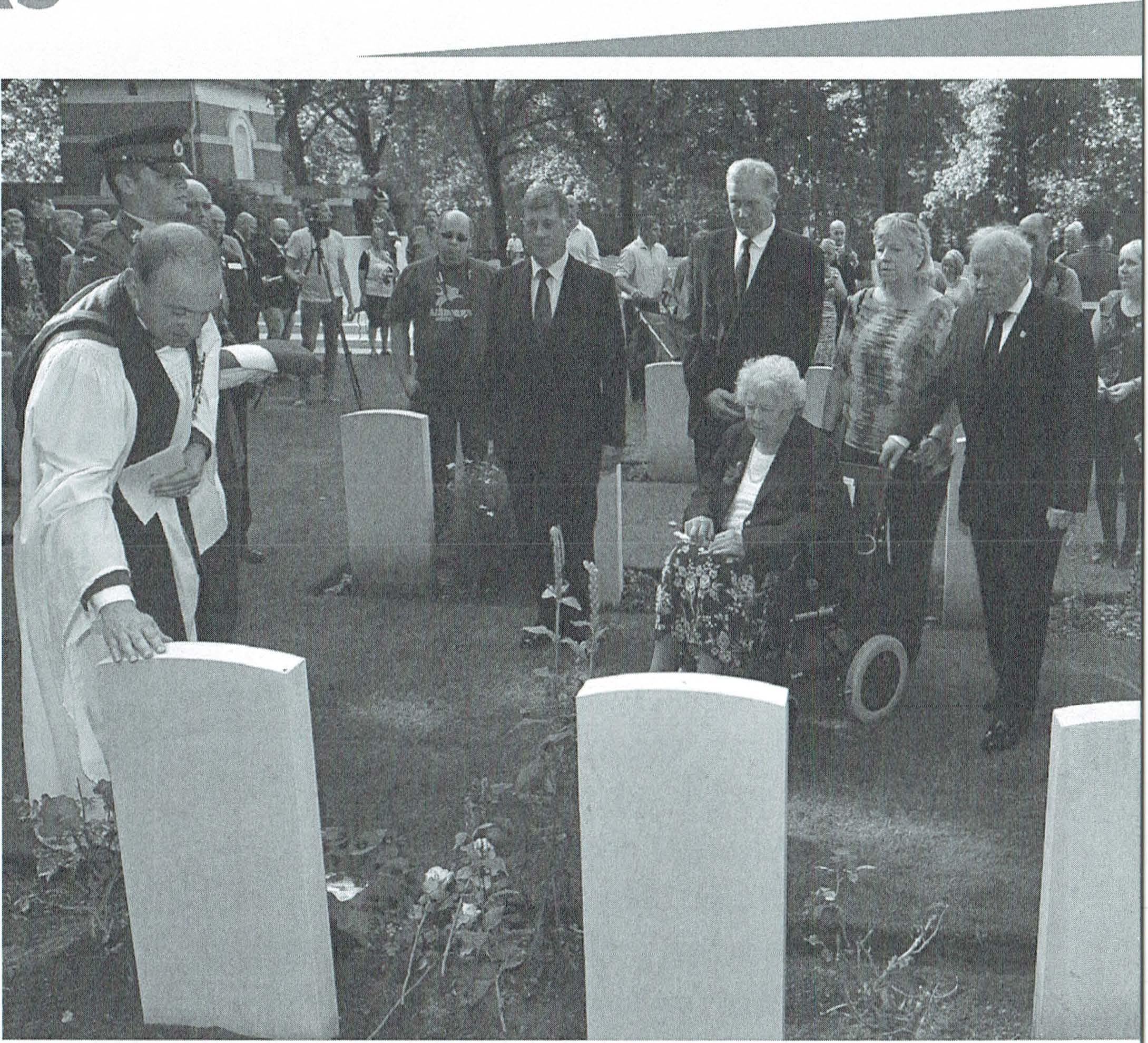
A sister of one of the identified soldiers from the Border Regiment, looks at the new grave stone other brother who died in 1944. (photo: berrydereusfotografie.nl)
BOOK REVIEWS BY WYBO BOERSMA
1) ‘Verzet via het geheime telefoonnet. De opmerkelijke rol van het PGEM-telefoonnet tijdens de Tweede Wereldoorlog” (Resistance via the secret telephone network. The notable role of the PGEM telephone network during WW2) written by Karel Berkhuysen; published by Wink Doetinchem 2016; 439 pages, illustrated; price: €29,95
In many publications, mention is made that the Dutch Resistance during WW2, made use of telephone connections, outside of the normal telephone networks. In this method, the Germans could not listen in. Even so, little is actually known about this subject. This in spite of the number of books written around this issue. Author Karel Berkhuysen has now written a new book, which, in a clear and understandable manner, reports and uncovers the role of various secret connections used by the Resistance. Using diagrams, he shows us how the various telephone networks were joined together. Mechanics who were in contact with the Resistance made these connections, often under the very eyes of the occupying forces. The whole system, comprised the public network and various other telephone systems. The most well known of these is the telephone network belonging to the Gelderland Provincial Energy Company (PGEM]. For those interested in Operation Market Garden, this network is most known because of the role this network played during Operation Pegasus 1. The Resistance had contacts throughout the whole province but the British made no use of this network, possibly because they did not trust the system. This was quite the contrast to the Americans in Nijmegen.
After the British blew up of the telephone exchange in Oosterbeek in the early part of the Battle of Arnhem, all the network connections in Oosterbeek were lost. After the Battle of Arnhem the PGEM connections were used to make Operation Pegasus 1 possible. The book gives a highly detailed story about this usage. It is also clear that the small telephone exchange that is kept in the Airborne Museum depot, played no role during Operation Pegasus 1. This exchange originated from the former SD (the German Sicherheitsdienst) building on the Utrechtseweg in Arnhem, but the connection for Pegasus 1 ran not from Nijmegen via Arnhem to Ede, but was direct from Nijmegen to Ede.
In the first chapter a detailed description is given as to how the secret telephone network was developed, which began in 1940. At that time, it was set up to serve the Dutch Army. In the chapters covering the period after September 1944, more is told about the Resistance and the liberation of the Achterhoek district (Eastern Holland), in relation to the secret telephone network.
In the book also, a few radio contacts and even postal pigeons are mentioned. A number of events during the War are described to put developments in the secret networks in the correct historical context.
The book gives a good and wide picture of the possibilities provided to the Resistance movement through the use of the secret telephone network and the telephone network of the PGEM. Members of the SFAM will especially be interested in the chapters about Operation Market Garden and Operation Pegasus 1.
The book is thus also a “must have” for those who will dig deeper into the role of the Resistance during and after the Battle of Arnhem. It would be good to have this book translated into English language, so that British people could learn more about these then unused facilities.
“Verzet via het geheime telefoonnet” is heartily recommended, but is not a book to finish reading in just one evening.
2) “Vergeten is Ballingschap, gedenken Verlossing” (Memorial book for Oosterbeek War victims, 17 September – 5 May 1945), written by Ron Wenting and Roland de Kwant.
A first edition was published as a private publication in November 2015, and now the SFAM has produced a second edition of this book. The book is written by Ron Wenting from Oosterbeek and Roland de Kwant from Zaandam. It records the 129 Oosterbeek civilians who, in the period between 17 September 1944 and 5 May 1945, died from War violence. Where possible, a short description is added of the circumstances under which they died. The book is well illustrated with black and white and some colour photos. The first edition was published with an issue of just 50 copies. That number was rapidly sold, but the authors did not have the means to produce a larger issue. The Management of the SFAM was of the opinion that such a thorough work, finally bringing the civilian victims of the Battle of Arnhem to the forefront, is extremely valuable and should be available to a wider public. As a result, we have financed the production of a further 100 copies. This second edition has, in the interim, nearly sold out. But a few copies are still available, amongst others at the Airborne Museum and the bookshop Meijer and Siegers in Oosterbeek. The price is €30. 3) “The Airborne Club, Three WW2 Airborne veterans tell their story” by Raymond P. Newlyn; Private publication 2015. 51 pages, illustrated, English language. Price £14.99
This private publication by author Raymond Newlyn records the history of three veterans, of whom two, Alex Hall and David W. Whiteman, fought at Arnhem. They both were part of the 181st Parachute Field Ambulance. The veterans write about the Battle in their own words and the book is easy to read. However, after so many years, it is questionable if all stories are historically accurate, but it is given so as they themselves now remember. Sadly, with some photos the ratio between the horizontal scale and the vertical scale, is not accurate, and as a result of which you get a distortion of some faces. This would have been easy to correct.
It is possible that Niall Cherry may still have a few copies of this book.
REGIMENTAL AID POST IN THE CONCERTZAAL
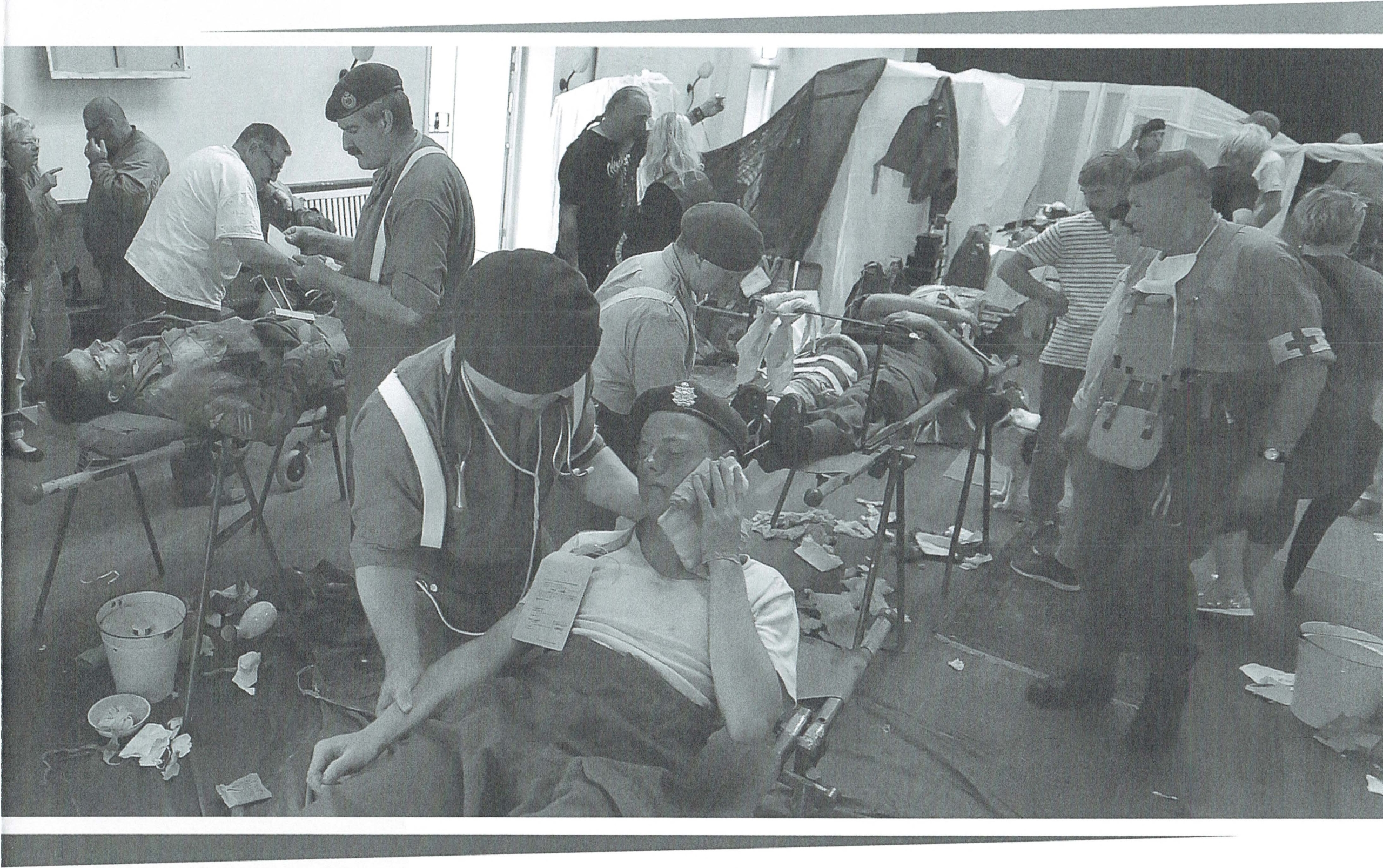
The ‘Regimental Aid Post’, that from 16-18 September2016 was installed in the Concertzaal in Oosterbeek, gave an impression of the circumstances, under which the British medical personnel had to work in September 1944. (photo: berrydereusfotografie.nl)
During the commemoration weekend last September 2016, for three days a ‘Regimental Aid Post’ was set up in the Concertzaal in Oosterbeek. This RAP was completely fitted out with material, and instruments, such as were used in September 1944 by the men of the Royal Army Medical Corps (RAMC). For this, a couple of British and Dutch collectors/re-enactors had taken the initiative to bring over their collections to the Concertzaal. The whole display appeared very realistic, the more so because a group of re-enactors acted as doctors, medical orderlies and patients. Especially this last group were carrying very professional make-up!
There was a lot of interest in this “living exhibition” not only from adults, but also from school classes.
Hopefully this interesting and educational event might be repeated in the future. (Robert Voskuil)
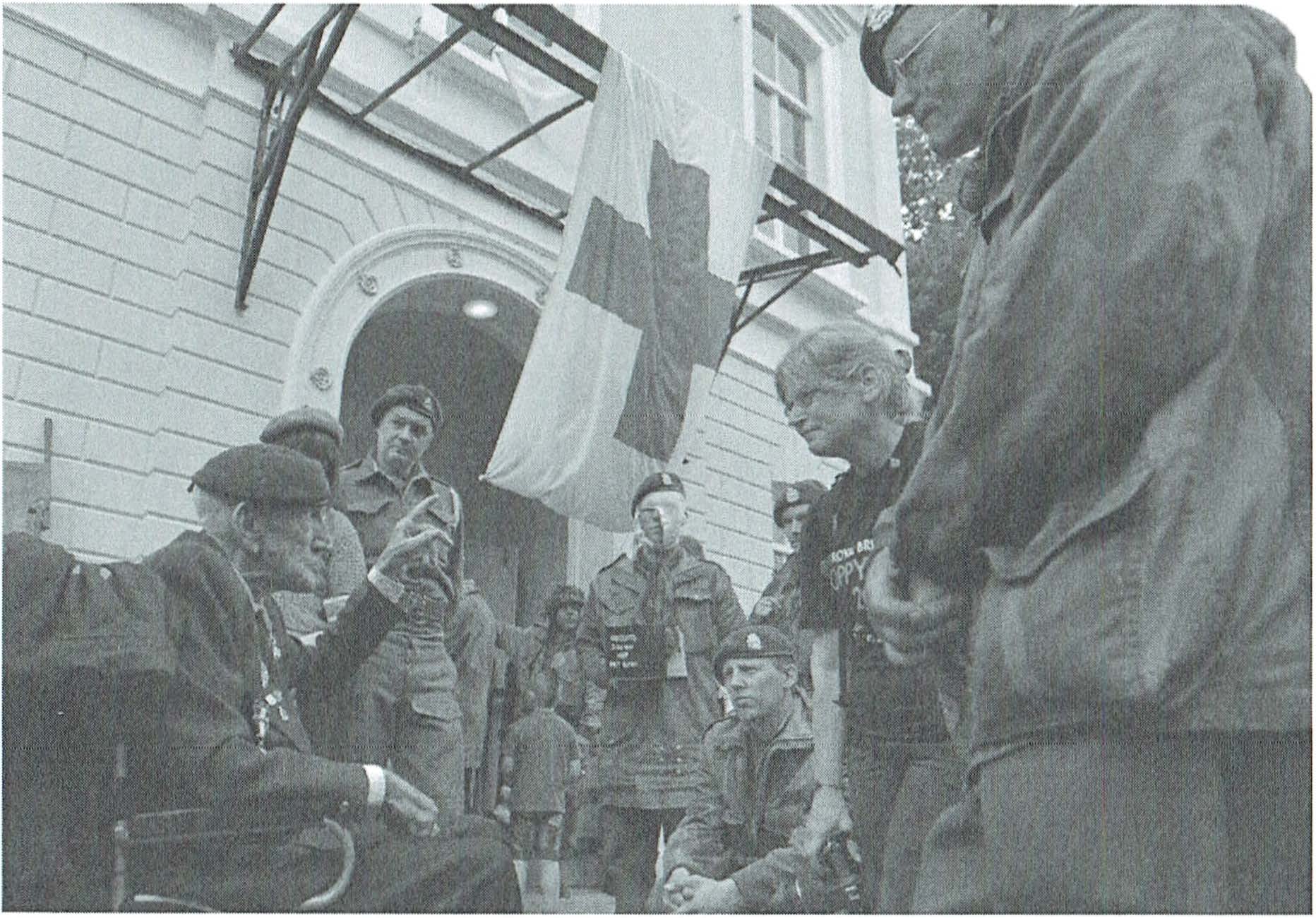
At the ‘RegimentalAid Post’ in the Concertzaal, a British veteran tells interested people about his own experiences during the Battle of Arnhem.
[photo: berrydereusfotografie.nl]
ROYAL DECORATION
In the recent past, three people who have devoted extensive time and effort towards research into a number of special aspects of the Battle of Arnhem, have been awarded a Dutch Royal decoration.
David van Buggenum from Arnhem has spent years researching missing military personnel from WW2, all of which have led to five identifications.
Hans Timmerman, also from Arnhem, has worked together with David van Buggenum. Also, Hans has traced ten missing German soldiers, via thorough archive research.
The now 82 year old Cor Janse from Rheden has been active for many years with all types of social organisations, but he is most known for his extensive research into the history of the Battle of Arnhem. His 3-part book set called “Blik Omhoog” (Look Up) covering the war history of Wolfheze and its surroundings is one of the results from all his research.
All three gentlemen have been awarded the “Membership of the Order of Orange-Nassau”
A VERY SPECIAL EMBLEM FROM THE AIRBORNE MUSEUM COLLECTION
A number of years ago, I was asked to assist with the making of the Dutch film “Zwartboek” (Black book), This is a film about a Jewish lady who thinks back as to how she survived the end of WW2, whilst in the Dutch Resistance. Our then member, Alex Junier, co-author of the book “By Land, Sea and Air”, also assisted, by providing some uniforms to the film company. The Airborne Museum at the time, received from him what for me was an unknown emblem: three white witches on a black background. The emblem was worn by personnel from MI9, the British Secret Service that, amongst others, was involved with the operations Pegasus 1 and 2, in October and November 1944.
I came across the same emblem later, when searching in the collection of the Combined Military Service Museum in Maldon, Essex, England but with other details. There it was incorrectly described as belonging to Scandinavia 159 Force.
Last year, a book appeared “Evasion and Escape Devices produced by MI9, MIS-X and SOE in World War 11” by Phil Room, in which we found a lengthy detailed description of the emblem involved.
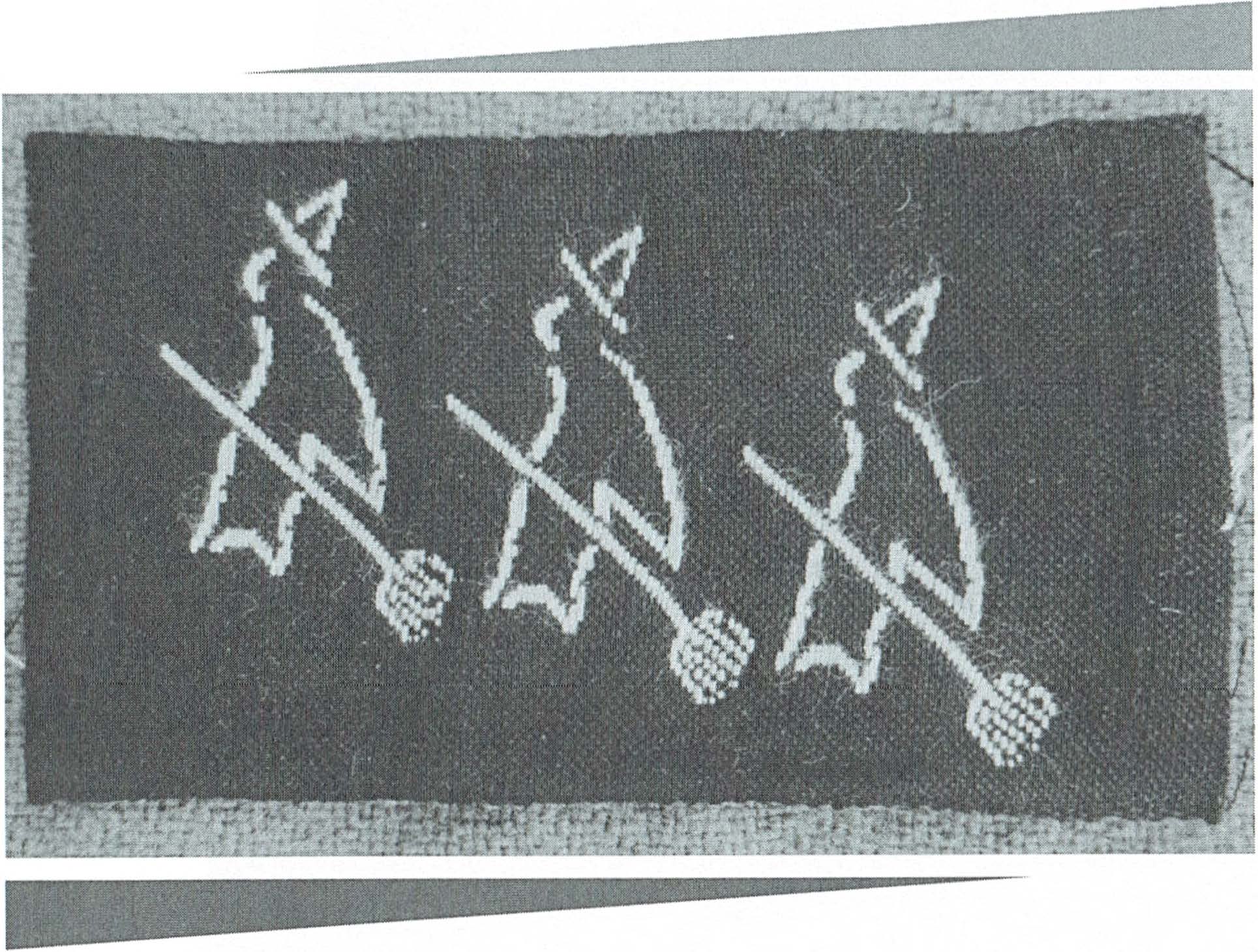
Front of the 3 witches emblem (photo: via Wybo Boersma)
The emblem consists of three witches on broom sticks with witches hats, completed in white cord on a black background. The size is 7 x 4 cm. The emblem is finished in the style of various other emblems, that were made in the Autumn of 1944 in South Netherlands, which was already liberated. The manufacturer is N.V. van Engelen & Evers in Heeze. There are three different versions. One on silk, one on thicker cotton and one which looks like a type of blazer badge. This last version, is possibly not much used.
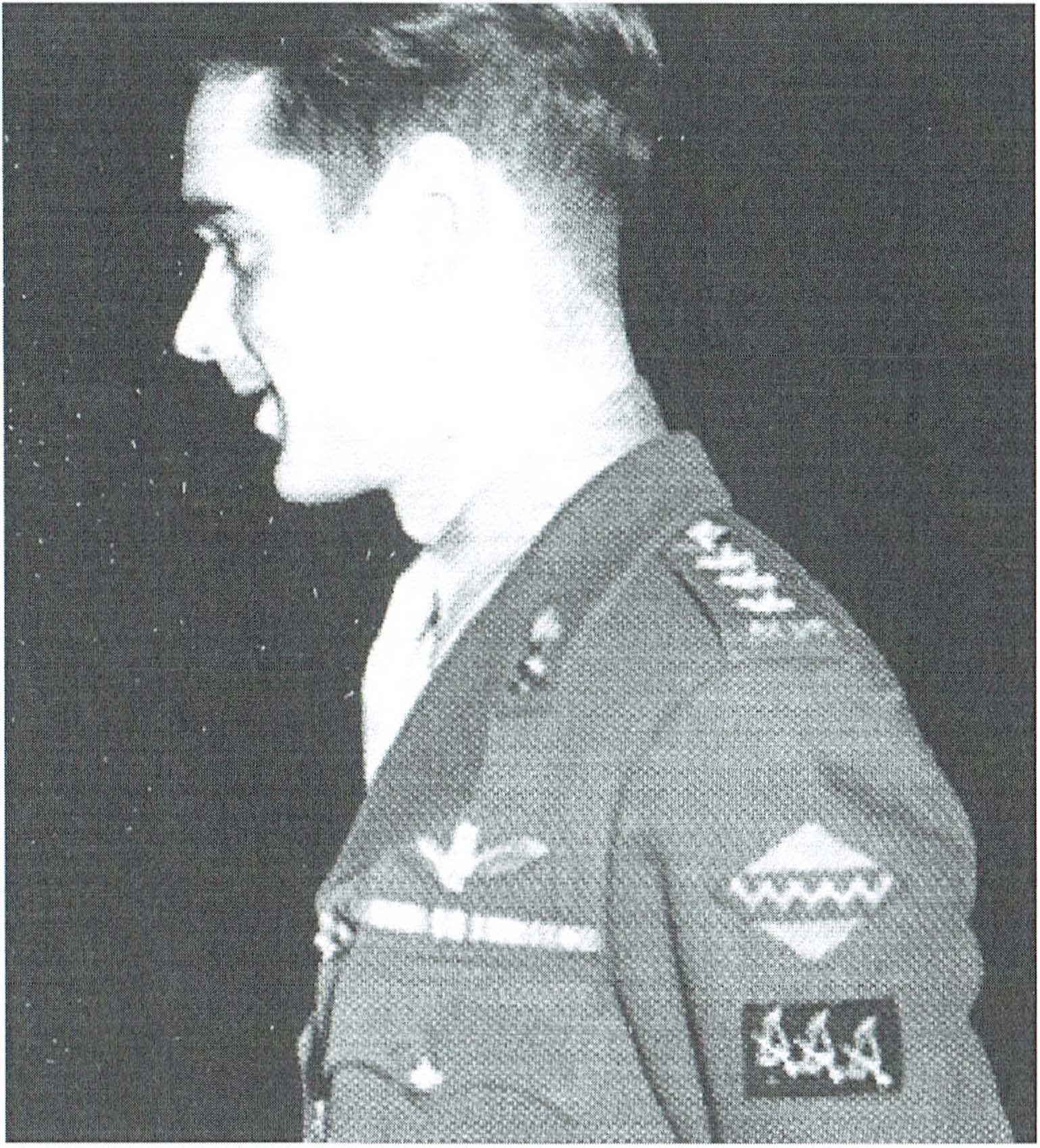
Captain George Swan, RCAF, pilot from A Flight 664 Squadron with the emblem carrying the 3 witches (photo: Department of National Defence, Library and Archives Canada No: PA-209539
The unofficial emblem was worn by personnel from Intelligence School 9 (Western European Area) of I.S.9 (W.E.A.) part of M.l.9. in the period from October 1944 until 26 June 1945. The design is by Dutch Lieutenant, later Captain, Leo Fleskens. After the liberation of South Netherlands, he was attached to IS9 and took part in the operations Pegasus 1 and 2. Until now, there is only one photo known of a military person wearing the emblem, a Canadian pilot of 664 Squadron RCAF. The “3 witches” emblem is with justification, one of the rarest items in the Airborne Museum collection.
(Wybo Boersma)
“B COMPANY ARRIVED, THE MEN”
In In 2003, the book “B Company arrived” appeared, in which, researcher and author David van Buggenum, wrote about the fortunes of B Company of the 2nd Parachute Battalion before, during and after the Battle of Arnhem.
In the last 13 years, David has continued with the collection of further information about this British parachute unit. Finally, with so much new material to hand, he decided to write a follow-up to his first book. In this new publication, a number of men from B Company stand centrally in seven short stories. Therein stands who they were, where they came from and what happened to them. One of the stories is about the Gronert twins, Thomas and Claude, who died together on 17 September 1944, during the advance to Arnhem. In this story and in those about the other men, also stand memories coming from family members. As well as the seven stories, the book also has a chapter with a large number of previously unpublished photos and documents of other men from B Company. Even though the book is presented as a Supplement, it is written in such a way that it can be read as an independent book.
“B Company arrived – The men” by David van Buggenum, which is written in English, is available in the Netherlands, amongst others from the Meijer & Siegers bookshop in Oosterbeek. Price: €30,-. In the UK it is available from Niall Cherry.
MINISTORY 124 Hotel Dreyeroord, September 1944 Niall Cherry
“Ladies and Gentlemen,
For those that do not know me, I am Niall Cherry, the Secretary of the Arnhem 1944 Veterans’ Club and also Secretary of the Arnhem 1944 Fellowship and I have mixed feelings as I stand here today. I am delighted that so many people, including my old friend Geoff Roberts who was here in 1944, have come but saddened that another piece of Arnhem history is under threat.
To many this building will be forever linked with the King’s Own Scottish Borderers – a Regiment that can trace its roots back to 1689 and during the Second World War one of its battalions was converted to an airlanding unit and so fought at Arnhem. This was, as many of you will know, the 7th Battalion. They had had mixed fortunes during their first few days in Holland -they basically spent the best part of their first two days defending various dropping and landing zones and on the afternoon of 19th September were ordered to rejoin the 1st Airlanding Brigade at Oosterbeek. Because of various misfortunes the Battalion now only numbered around 270 out of the original 760 or so who had landed on 17th September.
So by the late afternoon of the 19th September the survivors came into Oosterbeek and their war diary records the following:
1900 – Just as it was getting dark the Bn arrived in the vicinity of Div HQ (map coordinate) 693784. Major COKE had received orders from Bde HQ which was nearby and these were confirmed to the COY by a G2 of Div HQ. The Bn was to hold the right flank of the Div posns, covering the rly to the NORTH of Div HQ. There were already parties of glider pilots, RE and Independent Para Coy in that area and the Bn was to prolong EASTWARD the line held by them. The CO chose from the map his locality, which was a small wood area lying immediately EAST of 21 Indep Para Coy area. It was already dark when he, and 2IC set out to contact the Indep Para Coy and make a recce, the Bn being ordered to follow under Major COCHRAN. It was found during the recce that the area chosen consisted of the grounds and gardens of two large houses. It was a well-defined and convenient area to occupy in the dark and covered the Bn’s allotted tasks.
One of these two large houses was this building here -the Hotel Dreyeroord and the CO of the battalion later commented:
Comment from P-R (Lt.Col. Payton-Reid) – ‘I do not think that any who were there will forget the White House and its surroundings. When I knocked at its door about 9 pm on 19 September all was peace and quiet. Had I dropped from Mars I could scarcely have aroused more interest and I was immediately greeted as a liberator by the numerous occupants, it was, I found, a small hotel. Never have I felt such a hypocrite. I had come to announce my intention of placing soldiers in the grounds and vicinity and the delight with which this news was received was most touching – but at the same time most pathetic, as I knew I was bringing them only danger and destruction. By the next night the building was reduced to a shell and its inmates were crouching uncomfortably in the cellar.
It was then garrisoned by a section of men who were living in the eerie atmosphere of a haunted house. The moon shone through shot-holes in the walls, casting weird shadows, prowling footsteps could be heard on the enemy side and one felt that faces were peering through every window. There was, too, every reason to expect unwelcome visitors, since it was just outside that Major Sherriff and I were joined by a stray Bosch who was quickly disposed of by the former in unarmed combat.’
It may be interesting to add that Lieutenant Colonel Payton-Reid was one of the older commanding officers in the 1st Airborne Division as he had originally been commissioned into the KOSB in December 1915 aged 18 and so was one of the few Great War veterans present at Arnhem. At some point in 1943 when he was in command of the 1st Battalion they were inspected by General Montgomery as he wanted to see all the troops he had been allocated for the D-Day invasion and Monty noticed his Great War medal ribbons. Soon afterwards Monty who said P-R was too old to command the Battalion for the potential rigours of the Normandy invasion, got him posted to a supposedly ‘back water’ unit -the 7th Battalion then part of the Orkney and Shetland Islands defence force. Little did he or Monty know that within a year his supposedly too old soldier would be fighting in one of the most savage battles of the second world war.
So anyway between the 19th and 21st this area was the scene of much fighting some of it hand to hand as another of the veterans who is still with us but sadly not present here today, Sergeant George Barton who was a member of the Anti-Tank Platoon with his 6 pounder anti-tank gun was positioned in the grounds facing south with another gun nearer the road. He recalled ‘What a pounding we took from small arms fire and mortars including those terrible moaning mines. The noise alone was terrifying, finishing with an attack by the Germans. I always remember how lucky I was during this attack, as my Sten jammed and I stood there for what seemed like hours waiting to be shot by the Germans, but they just rushed past me. I then picked up a rifle and Colonel Payton-Reid rallied us and we drove them out with the bayonet.’ During the night of the 21 st/22nd September the KOSB were pulled back to defensive positions further south but the White House will forever be remembered by the survivors, their friends and relatives. It is pleasing to see so many staunch supporters of the KOSB here and the memory of the Battalion lives on in the form of two excellent books on the unit – “Off at Last” and “Nine Days at Arnhem”.
Sadly as we all know this building is now in a state of limbo with the threat of demolition hanging over this historic ground. I urge all of us here today to at least sign the petition to save the building. It will be a tragedy if this iconic building is not saved and an insult to the brave men of the 7th King’s Own Scottish Borderers and other units who fought and died in this area. So I urge everyone here today to spread the word and to keep up the pressure so that we can save this historic building.
Thank you.
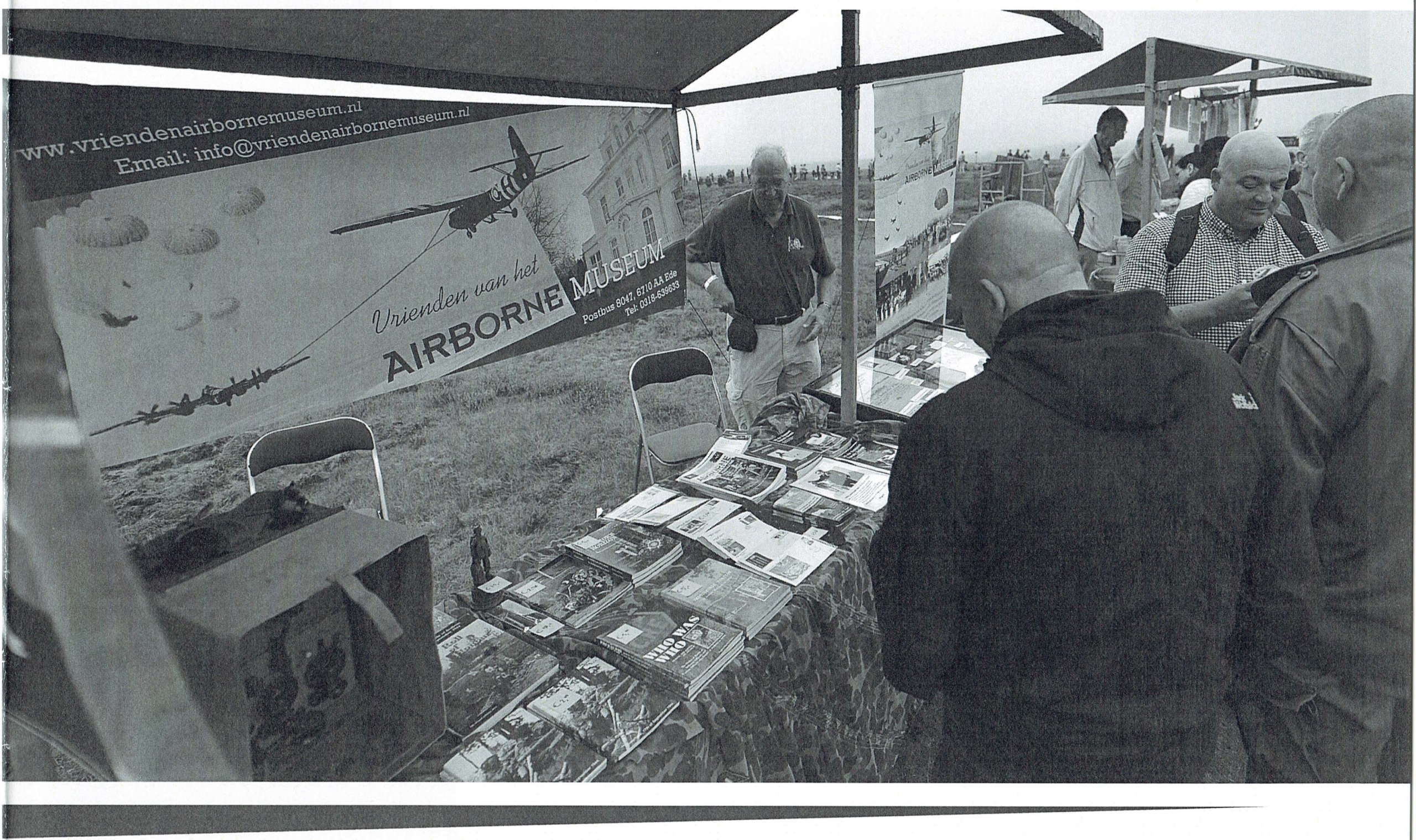
During the commemoration of the Battle of Arnhem on Ginkel Heath on Saturday September I7h 2016, Wybo Boersma runs the ‘shop’ of the Society of Friends. (photo:berrydereusfotografie.nl)
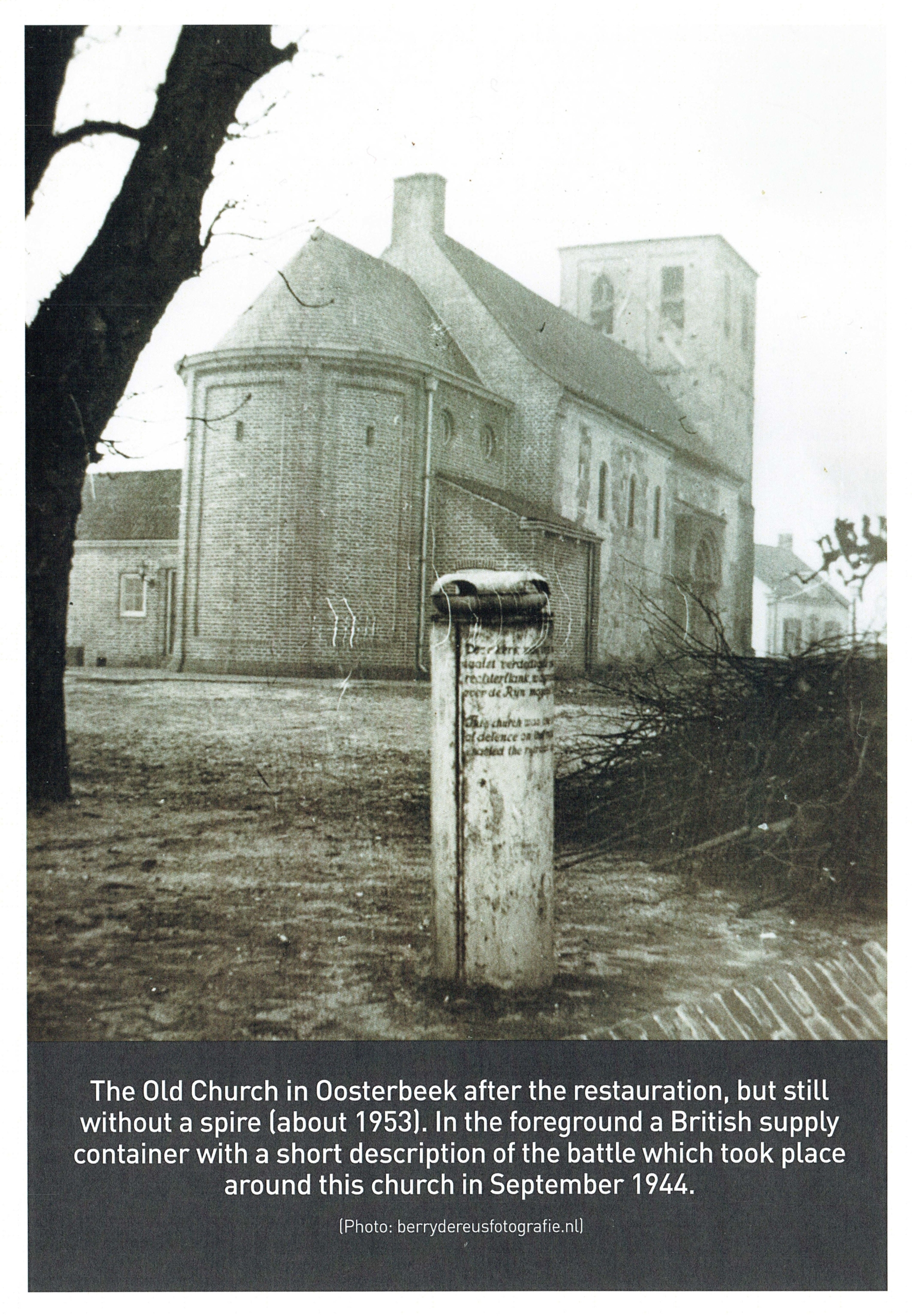
COLOFON
The Airborne Magazine is a publication of the Society of Friends of the Airborne Museum Oosterbeek (SFAM] and appears three times per year. The objective is to promote the Airborne Museum, the SFAM and the history of the Battle of Arnhem.
Editors: Wybo Boersma MBE (Vacancy)
Archiving and distribution of back numbers of the magazine: Wybo Boersma, Ede, w.boersmaldwxs.nl
Translation: Peter Burton, London, UK
Design: Michal Kuscielek Artefakt Design, Nuenen
Print: Wedding Proson, Harderwijk E-mail address SFAM: info0vriendenairbornemuseum.nl Telephone: 0318 639633 Postal address: SFAM, W. Boersma Binnenhof 38, 6715 DP Ede, The Netherlands Coordinator Airborne News Flash: Vincent Luiten
Representative in the UK: Niall Cherry.
Email addres: Niall.Cherry0baesystems.com
Download the magazine in pdf format

Plaats een Reactie
Vraag of reactie?Laat hier uw reactie achter.